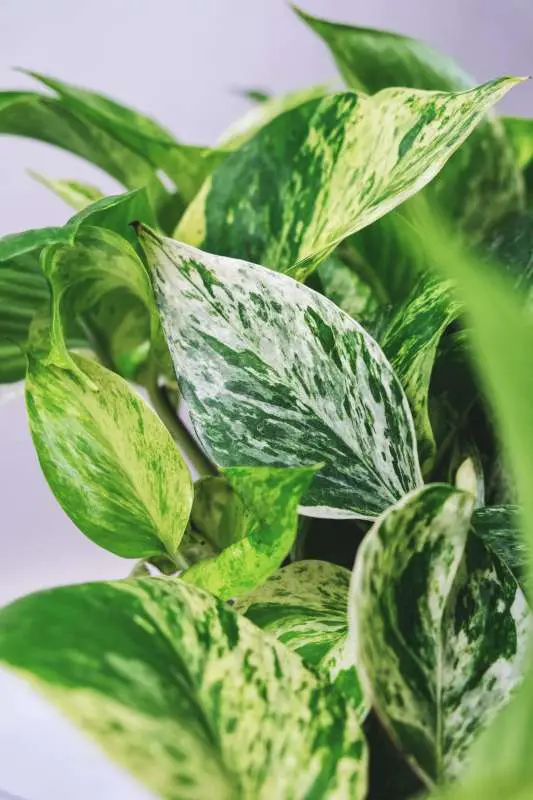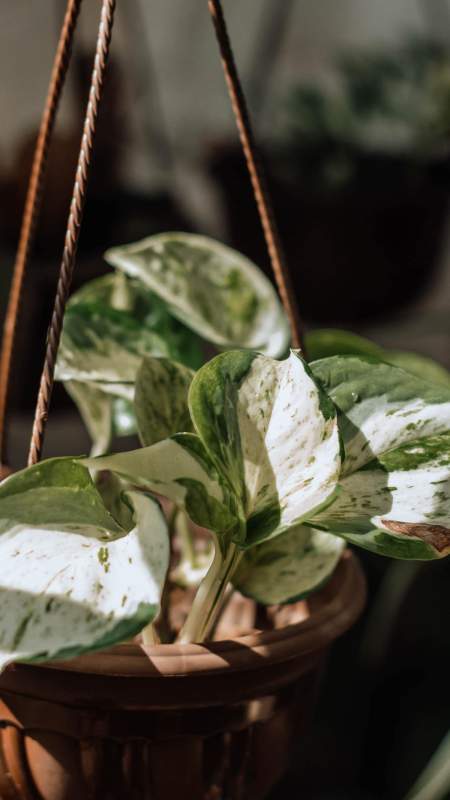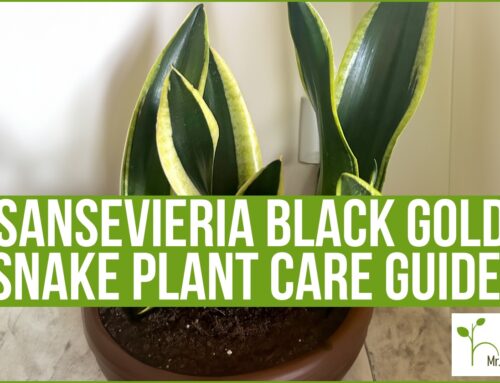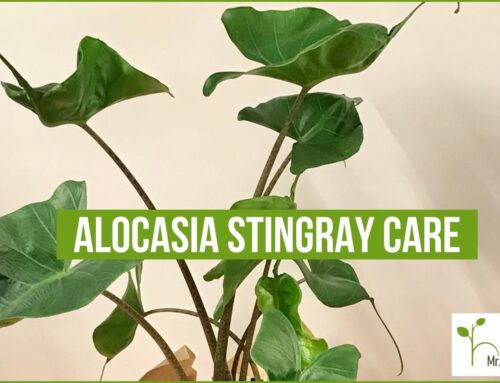
What is the best Pothos Plant care? What diseases can affect this plant? What are the varieties of the Pothos plant? Keep reading to find the answers to these questions and also the important tips about temperature, light, proper watering, humidity, soil, propagation, and repotting.
| Botanical Name (Latin Name/Scientific Name): | Epipremnum aureum |
| Common Name: | Pothos; Devil’s Ivy |
| Light: | low light tolerant (50 lux – 750+ lux) |
| Watering: | when the top half of the soil dries out |
| Soil: | well-draining mix |
| Repotting: | Once a year |
| Temperature: | 65°F to 75°F (18°C to 24°C) |
| Humidity: | 25% to 50% but it adapts well to any humidity |
| Toxicity for Pets: | Yes (mouth and tongue irritation, vomiting, problems with swallowing and drooling) |
| Toxicity for Humans: | Yes (can irritate mouth, throat, skin, and tongue) |
| Propagation: | 1) stem cuttings in water 2) stem cutting in soil 3) layering |
| Pruning: | prune dead or diseased growth or when you want the plant to branch out |
Light Requirements
| Minimal amount of light: | 50 Lux (5 FC) |
| Optimal amount of light: | 2,000+ lux (200+ FC) |
| Direct sun tolerance: | low light tolerant |
| Category: | 3-4 hours |
Pothos plant is a low light tolerant plant, it can tolerate light levels as low as 50 lux (4 foot candles). Optimal amount of light is over 2,000 lux (over 200 foot candles). More light will provide more leaf growth for Pothos, more stem growth, and a healthier plant. With more light, Pothos will also be more resistant to pests and diseases. To provide the optimal amount of light, place your Pothos in front of a west, or east-facing window. The following research and expert guidance illustrate these points.
- Low light tolerant plant. A 2020 study “Lighting for indoor plants and starting seeds” by Julie Weisenhorn and Natalie Hoidal, horticulture educators and Neil Anderson, a horticulture professor from the University of Minnesota Extension, confirms that Epipremnum Aureum plant is a low light tolerant plant. David H. Trinklein, Horticulture State Specialist from the Division of Plant Sciences, University of Missouri, in his publication “Lighting Indoor Houseplants” from 2016 also classifies pothos as a low light tolerant plant.
- The optimal amount of light is over 2,000 lux. Bodie E. Pennisi, Professor at the University of Georgia in her publication from 2006 “Growing Indoor Plants with Success” confirms the optimal amount of light for a Pothos plant is over 2,000 lux (200 foot candles).
- More light will provide more leaf growth and more stem growth. According to James E. Faust, Associate Professor of Horticulture at Clemson University and his research “Light Management in Greenhouses”, more light leads to more leaf growth, more branching, and a higher quality plant. The research also confirms that low light tolerant plants grow best in bright light conditions.
Bright indirect light over 2,000 lux is the best for the Epipremnum aureum plant, but the more light you can provide, the better it will do and the faster it will grow. For example, my Pothos plant sits in front of a south-facing window, and on sunny days it gets direct sunlight from 11 am until 4 pm. It receives bright indirect light over 7,000 lux, plus a lot of direct light/direct sun which increases the light to 40,000-100,000 lux. With this amount of light, it grows one leaf per week on each stem, which is amazing!
When these houseplants get sufficient bright indirect light, they will have a lot of variegation and sometimes will even develop fenestrations. If yellow variegation is not visible on the leaves of your Golden Pothos, know that lack of bright indirect light is the culprit.
Although Epipremnum plants can tolerate very low levels of light and survive, they like bright indirect light. The less light they receive, the slower they will grow. One of my Pothos plants that I’ve had for about 3 or 4 years sits in a dark corner of my kitchen with about 50 lux of light. Due to extremely low levels of light, it only grows a few leaves per year.
Water Needs
Water Pothos plant when the top half of the potting soil dries out. The following expert guidance illustrates this point.
Bodie E. Pennisi, Professor at the University of Georgia in her 2006 publication “Growing Indoor Plants with Success” confirms that the optimal watering for Epipremnum Aureum is once the top half of the soil dries out.
If you’re not sure whether to water, wait a bit longer. It’s better to underwater than to overwater Pothos.
The only way for plant cells to expand to their full size is to provide them with enough water, so if you want your Pothos leaves to grow to their maximum size, make sure to provide them with sufficient water. Also, provide a trellis for the plant to climb.
Remember that the amount of light, porousness of potting soil, and the pot material will affect the frequency and amount of watering. If the pothos receives more light, its soil is porous, and it’s potted in a terracotta pot, its soil will dry out faster and you will need to water pothos more frequently. For example, my Pothos plant is potted in a well-draining mix that consists of 50% fresh potting soil and 50% perlite, in a terracotta pot. It dries out very fast, so I water it thoroughly twice a week. It’s very difficult to overwater a plant that gets a lot of light and is in a well-draining potting mix.
Humidity Needs
The optimal humidity for Epipremnum Aureum plant is between 25% to 49%, however, Pothos adjusts well to lower and higher humidity. The following expert guidance confirms this point.
Optimal humidity between 25% and 49%. Bodie E. Pennisi, Professor at the University of Georgia confirms in her 2006 publication “Growing Indoor Plants with Success” that the optimal humidity for pothos is between 25% and 49%.
Pothos adjusts well to lower and higher humidity. Carol Allen, Instructor of Biology and Biodiversity from the University of Maryland confirms that houseplants, including pothos, adjust well to lower and higher humidity.
Temperature Requirements
The optimal room temperature for a Pothos plant is between 65F (18C) and 75F (24C). It will grow well in temperatures up to 90F (32C). If you can provide a room temperature between 75F and 90F Pothos will grow faster. The following research and expert guidance illustrate these points.
Optimal temperature. Bodie E. Pennisi, Professor at the University of Georgia in her 2006 publication “Growing Indoor Plants with Success” confirms that the optimal temperature for Pothos is between 65F and 75F.
Grows well up to 90F. Susan Mahr, Statewide Master Gardener Program Coordinator at the University of Wisconsin-Madison confirms that Epipremnum Aureum grows well at temperatures up to 90F.
Temperature between 75F and 90F provides faster growth. Research by James E. Faust, associate professor of horticulture at Clemson University, confirms that a higher temperature provides faster leaf development and has a big impact on plant quality.
Fertilizing
If you repot your Pothos plant once a year, it will be getting enough nutrients from the soil. But my Pothos grows very intensively, so I need to fertilize it occasionally as well. If it’s a similar situation with your Pothos, I suggest you do the same. I recommend the fertilizer that I use for all foliage plants, with a 9:3:6 N-P-K ratio, the Sill fertilizer.
But remember, only use fertilizer if the plant is growing. If it’s not getting enough light, it will be growing very slowly, so adding fertilizer in this situation could even be harmful to the plant. If a plant is growing very slowly, it doesn’t get the chance to use all available minerals in the soil. By adding more minerals through fertilization, they continue to accumulate in the soil and over time their concentration will start damaging the roots.
Soil
Healthy roots are the basis of a healthy plant, so porous, oxygenated, fresh potting soil is best for Pothos plants. You will create it by mixing 1 part any peat moss based potting mix, 1 part perlite, 1 part bark. This mix will create a nutritious, oxygenated potting soil that Pothos loves. The following expert guidance has confirmed this. Bodie E. Pennisi, Professor at the University of Georgia confirms in his 2006 publication “Growing Indoor Plants with Success” that the best soil for pothos contains 1 part peat moss, 1 part perlite, and 1 part bark.
Repotting
I recommend regularly repotting your hanging Pothos plant once a year or once every two years, to reduce soil compaction, salt accumulation, and nutrient deficiency.
Take the pothos out of the pot, gently press the rootball on all sides in order to loosen it and put the plant in a slightly larger pot.
It is not necessary to use a larger pot each time you repot it because Pothos will do well in a smaller pot, too. But if the roots are coming out through the drainage holes or are curling up at the soil surface, it’s time for repotting. Also, if you want your Pothos plant to grow faster, besides light, providing a larger pot will help as well. But if you want to keep the same pot size, you can do that, make sure to trim some of the roots, so they have room to grow in the same pot.
Make sure to select an appropriate pot by getting the next pot size; if your plant is in a 4” pot, get a 6” one, and if it’s in a 10” pot, get a 12” one.
In case you choose a pot that is too large, it will contain too much soil, which would take a long time to dry out, and can slowly lead to the plant’s root rot.
This was so-called “potting up”. If are more experienced you can also try to do a full repot. To learn the difference between potting up and a full repot or if you need more detailed instructions on how to properly repot a houseplant, I got you covered. Check out that previous link.
Toxicity To Humans
Pothos plants are toxic to humans. These plants contain oxalate crystals that, if ingested, can cause pain, swelling, irritation, and difficulty breathing, and speaking. The plant’s sap can lead to skin rash and irritation. The following research and expert guidance illustrate these points.
Pain, swelling, irritation, difficulty breathing, and speaking. The California Poison Control System (CPCS) confirms that the sap of Monstera plants contains tiny oxalate crystals and that chewing on these plants can cause immediate pain and irritation to the lips, mouth, and tongue, and even breathing problems and swelling in the throat. Children’s Health Queensland Hospital from Queensland, Australia also confirms that ingesting the plant can cause difficulty breathing, swallowing, and speaking.
Skin rash and irritation. Ann King Filmer, a Plant Scientist from the University of California, confirms in her publication “Safe and Poisonous Garden Plants” from October 2012 that the sap of the plant contains oxalate crystals which can cause a skin rash or irritation. If you get the sap on your skin, wash the affected area with soap and water as soon as possible. Ann also confirms that the pothos plant can irritate the mouth, tongue, and throat which can result in burning pain, throat swelling, and difficulty breathing.
Toxicity To Pets
Pothos plants are considered toxic to pets. Pothos contains calcium oxalate which causes intense pain, irritation of the mouth, tongue, and lips, excessive drooling, vomiting, and difficulty swallowing.
The following research and expert guidance illustrate these points.
Intense pain. Cecil F. Brownie, an expert from the College of Veterinary Medicine, North Carolina State University in her Merck Veterinary Manual states that pothos contains calcium oxalate and can cause intense pain.
Irritation of mouth, tongue, and lips, excessive drooling, vomiting, and difficulty swallowing. American Society For The Prevention Of Cruelty To Animals (ASPCA) states that ingesting pothos will cause the aforementioned symptoms. If you suspect your pet may have ingested a toxic substance call your local veterinarian as soon as possible.
Pruning
To prune your Pothos, use a pair of sharp, sterilized scissors or pruning shears. If you want to create a bushy plant, prune 2 inches above the soil, to create short stems from which new leaves will emerge. Pruning them will stimulate new growth. To shorten a long vine, prune it wherever you prefer. To remove brown or yellowing leaves, pull the leaves off with your fingers together with the petiole. To prune diseased or pest-infested leaves, cut them off at the base of the petiole.
Propagation
Epipremnum aureum is one of the easiest house plants to propagate both in water and soil.
Here’s how to propagate Pothos in water.
- Cut a stalk. Generally aim for it to have no more than 2 to 3 leaves and 2 to 3 nodes. You can propagate even longer pothos stems, but you can also split them into shorter stems, in order to get more than 1 plant. Nodes are parts of the stem where leaves grow, or used to grow, and it’s where new roots will form.
- Place the cutting in water. Put it in a spot with bright indirect light. Aim for light over 3,000 lux. Replace water once every 1 to 2 weeks or as soon as you notice it getting dirty.
- Within a few weeks, you should see new roots growing. When they grow 1 to 2 inches long, plant cuttings in soil.
Recently, I decided to propagate two Pothos cuttings — one in water and the other one in soil. You can see the process in the video below (jump to the end of the video to see the results):
The one propagated in water was positioned in my southwest-facing window, getting direct sunlight from 11 am until 4 pm.⠀
The soil propagated Pothos cutting was under a grow light, on a 16-hour photoperiod, getting between 10,000-15,000 lux of light (1,000-1,500 foot candles). You can use a LED grow light or fluorescent lighting.
When propagating in soil, I recommend keeping the humidity around the plant high, ideally 70%-80% because humidity levels influence transpiration. Optimizing moisture during propagation is a balancing act between water absorption and transpiration. When the humidity in the microenvironment around the plant is low, transpiration increases, causing cuttings to wilt faster. Until roots form and gain the ability to replace lost water, it’s important to minimize water loss. I used plastic bags to keep the humidity high because this helps reduce evaporation/water loss from the leaves. ⠀
After almost a month, both plants rooted well.⠀
Pests
The most common pests affecting Pothos are: mealybugs, scales and spider mites.
To get rid of the pests, you can go the organic way and use neem oil, which acts as a repellent and disrupts insect feeding. Mix 5 drops of neem oil, 5 drops of dish soap, and 16oz of water. Put the mixture in a spray bottle and spray your Pothos thoroughly. Make sure to spray the underside of the leaves, too. Dish soap is added to aid the mixing process since water and oil do not mix well, and without the soap as emulsifier, they would separate.
Neem oil is a great remedy for minor infestations. However, if the infestation is severe, you can use systemic insecticides. They are effective for treating mealybugs and scales infestations, however, they’re not effective against spider mites.
Diseases
| Disease | Symptoms | Cause | Treatment | Bacterial/Fungal |
| Phytophthora root rot | It starts in the roots. It can infect leaves and the whole plant. Leaves turn dark brown to black. |
Phytophthora nicotianae | Discard the plants that are infected. | Fungal |
| Bacterial wilt disease | Wilting leaves. Veins in leaves and stems become black. Bacterial ooze on recently cut stems. | Ralstonia solanacearum | Tool sterilization. Discard the plants that are infected. | Bacterial |
| Rhizoctonia root rot and aerial blight | Irregular, dark spots on the leaves. If it infects roots during propagation cuttings can die. | Rhizoctonia solani | Remove the infected plants, use fungicides (triflumizole or thiophanate-methyl). | Fungal |
| Bacterial leaf spot | Water-soaked lesions on the leaves with a yellow border. | Pseudomonas cichorii, Erwinia carotovora, and E. chrysanthemi |
Choice of clean cuttings and tool sterilization. In some cases can be controlled by eliminating water on leaves. If not, discard infected plants. | Bacterial |
| Cutting soft rot | The lower end of a cutting will have mushy and soft rot and plants can have a fishy smell. | Erwinia carotovora and E. chrysanthemi |
Choice of clean cuttings and tool sterilization. | Bacterial |
| Pythium root rot | Poor rooting and yellow leaves on cuttings, mushy dark rot on the leaves and stem. | Pythium splendens | Planting material free of diseases, watering reduction, sterilized potting mix. | Fungal |
| Southern blight | Water-soaked lesions on leaves, stem rot, and wilting, root rot. | Sclerotium rolfsii | Discard infected plants. | Fungal |
Common Problems
Yellow Leaves
As the plant ages, the oldest leaves will start to yellow and fall off. This is a normal and expected life cycle of most plants. So, if your Pothos is getting a few yellow leaves here and there, there is no cause for panic, just pluck them off once they dry out and turn brown. However, if your Pothos starts losing many leaves in a short amount of time, make sure to check whether the soil has fully dried out (underwatering). If the soil is fully dry, the leaves will start to curl and droop and to turn yellow. Another reason why pothos leaves will turn yellow is overwatering (the soil staying wet too long). This will cause root rot and yellowing of leaves. What is too long? If it’s been 10-15 days since the last watering and the soil is still wet, that is too long.
Also check the plant closely for pests, as they can cause leaf yellowing. Some pests are very small and hard to notice with the naked eye, it’s best to use a micro lens or a microscope. A lot of pests will hide on the underside of the leaves, so make sure to check it. When it comes to macro lenses, this one can be attached to any cell phone. Or if you prefer to take even better pest photos, my favorite microscopes are this one and this one.
Curling, Wilting Or Droopy Leaves
Curling, wilting or droopy leaves on Pothos plant can be caused by cold temperatures, or if the plant is overwatered or underwatered. Check the soil moisture with a chopstick. If the soil is fully dry water it thoroughly and the leaves should go back to normal within a few hours. If the soil is wet and it’s been 10-15 days since the last watering, the leaves are wilting due to overwatering. In that case, move the plant to a brighter location.
Brown Edges, Brown Leaf Spots Or Brown Patches
If brown edges/spots/patches on your Devil’s Ivy occur every once in a while on a few leaves, I wouldn’t be too concerned. This may be just a sign of a slight issue with watering or fertilizing. It could also be a bacterial or fungal disease. But in order to differentiate between all of these, I will have to write a separate blog post on the topic.
I recommend flushing the soil occasionally to let the water drain away built-up minerals.
There are also studies showing that brown edges on Pothos leaves can also be caused by applications of fungicides containing mefenoxam. If you’ve recently treated your pothos with a fungicide, check whether it contains mefenoxam.
All in all, if your plant is generally healthy and enjoys lots of light, along with proper watering and nutrition, feel free to enjoy it even though a few leaves get brown edges, yellow, or even die off here and there. Houseplants are never perfect in nature, they can’t be perfect in our homes.
Lack of Variegation
If your Pothos leaves are lack variegation (they are reverting to solid green color) your plant isn’t getting enough light. When a variegated plant lacks light, it starts producing solid green leaves in an effort to photosynthesize. To promote variegation and healthy growth, give your Pothos over 2,000 lux (over 200 foot candles) of light. With enough light, your Pothos will grow variegated leaves and grow faster.
FAQs about Pothos Plant
Is Pothos easy to care for?
Pothos plant is one of the easiest houseplants. This houseplant can tolerate a lot — from low light to light watering. This is why many novices in the world of plant care choose Pothos as one of the first houseplants to start their journey with.
However, as you learn and gain more experience, it is highly desirable to give Pothos the conditions to thrive, not just survive. Although Pothos can tolerate less than optimal conditions and survive them, it doesn’t mean that it will thrive; It will just live and survive.
How fast can Epipremnum Aureum grow?
Epipremnum aureum is well-known as a fast grower, but only if it gets enough light. For example, the hanging Pothos I brought from Florida has been growing a leaf per week on every stem ever since I’ve brought it. Since it has around 10 stems, that means 10 new leaves each week!
But for this to happen, it is necessary to provide the right amount of light — over 7 to 8,000 lux, plus a lot of direct light/direct sun which increases the light to 40,000-100,000 lux. Some other factors need to be favorable as well — porous, oxygenated soil, proper watering (water when the top half of the soil dries out, if not sure, go on the side of underwatering), regular repotting (once a year), proper PH, and potentially occasional fertilizing (I use the Sill fertilizer), as mentioned earlier.⠀Be careful with direct sun though. Pothos is not a full-sun plant and too much light or exposing the plant to direct sun during the most intense hours (11am to 3pm) can burn the leaves.
Check out my video on how to grow 500 leaves per year on golden pothos:
How To Grow Large Leaves On Pothos?
If you want your Pothos’ leaves to increase in size, the first factor is sufficient light. Your Pothos needs to get bright light (light over 3,000 lux or over 300 foot candles). The second factor, your Pothos should climb, instead of hang. Even though many plant lovers let Pothos hang, in its natural habitat, Pothos climbs to get more light. As it gets more light and matures, if all the other conditions are fulfilled — proper watering, proper PH, proper nutrition — it will grow larger leaves.
To allow your Pothos to grow large leaves, insert a wooden stake or a totem and attach the stems of the plant to it. Here’s how I did it.

Mr. Houseplant with a large Pothos plant he brought as a small cutting from Florida
Are There Different Varieties Of Pothos Plant?
Yes, there are. The most common variety is Golden Pothos, which you’ve just seen in the photo with me. Then there is Marble Queen with moss green leaves with white variegation.

Close up shot of a Marble Queen Pothos plant
Neon Pothos has a lime green color that deepens as the plant matures. Jessenia Pothos is a variety similar to Marble Queens Pothos, with yellow variegation instead of white. Another variety similar to Marble Queen and Jessenia is Manjula Pothos with unique shape and variegation on the leaves. The leaves are variegated with cream, white and green colors. The variegation is often layered, so you can sometimes see a splotch of green underneath a variegated leaf section.

Manjula Pothos plant
Pearls & Jade Pothos’ variegation occurs predominantly on the edges of the leaves. N’Joy Pothos is often confused with Pearls & Jade Pothos but actually is a much slower grower and, when it comes to appearance, it lacks the tiny splashes of green on its leaves.
How Do I Stake My Pothos?
If brown edges/spots/patches on your Epipremnum occur every once in a while on a few leaves, I wouldn’t be too concerned. This may be just a sign of a slight issue with watering or fertilizing. It could also be a bacterial or fungal disease. But in order to differentiate between all of these, I will have to write a separate blog post on the topic.
I recommend flushing the soil occasionally to let the water drain away built-up minerals.
There are also studies showing that brown edges on Pothos leaves can also be caused by applications of fungicides containing mefenoxam. If you’ve recently treated your pothos with a fungicide, check whether it contains
All in all, if your plant is generally healthy and enjoys lots of light, along with proper watering and nutrition, feel free to enjoy it even though a few leaves get brown edges, yellow, or even die off here and there. Houseplants are never perfect in nature, they can’t be perfect in our homes.
There is a video demonstrating the process of staking Pothos from Florida to 2 wooden stakes:
Why Is My Devil’s Ivy Growing Huge Leaves?
In nature, Pothos (common name Devil’s Ivy) is a climbing plant that uses its aerial roots to absorb moisture and nutrients, but also to help with climbing. However, if you’re growing Pothos in your home, you can have it cascade downward, grow horizontally, or grow it up a stake or a plant totem — it’s totally up to you. But if you want your Pothos to develop large leaves and grow healthy and happy, I suggest providing conditions as similar to those in nature as possible.
Do You Have More Questions on Pothos Plant Care?
Pothos is a houseplant everyone should consider having. Ease of plant care and its beautiful appearance are sufficient reasons.
I hope you now have all the answers about Pothos plant care but if you happen to have any other concerns or more questions about it, feel free to leave a comment. For diagnosing and treating your pothos, you can also reach out and schedule a consultation with me. Pothos is one of the houseplants I enjoy the most and I will be happy to help you get back a beautiful, healthy plant.
Yours Truly,





Hi!!! You’ve just got a new follower😍😍
Thanks a Lot for this excellent and deep knowlege about potos. May You please enlighten My path to the Best pothos?😅😅😅 When You Say they need xxx Lux is the total luxes/day or it means xxx luxes every moment for x hours/day? I mean if the spot is getting 50 luxes * 12 hours = 600 luxes? Or is 50 luxes only? Thanks again!!!!
Hi Renato, excellent question! 50 lux minimum means 50 lux on average for the whole day. Let’s say the daytime length is 12 hours, that would be 600 lux per day minimum. Hope this helps :)
I believe your terminology here is misleading and adding to the confusion. 50 lux for 12 hours if 600 lux-hour equivalent per day, not 600 ‘lux per day’ as it never received more than 50 lux. It is also important to understand that there is a minimum threshold for photosynthesis that varies by plant. A theoretical plant might be ok with 400 lux for 6 hours per day (2400 lux hours), but might not survive at 100 lux grow light despite getting this light 24 hours per day. Conversely a plant might thrive on 1000 lux, 24 hours per day, but be mighty sunburnt after 24,000 lux for 1 hour.
I sincerely appreciate your quantitative and researched approach! Hope this helps!
Hi Zach, thank you for sharing and apologies it took me a while to respond, I somehow missed this comment. I appreciate your thoughts on the matter.
You’re right, a plant might thrive on 1,000 lux for 24 hours but get burned at 24,000 lux (maybe this is not the perfect example, because at 24K this is still indirect light, and a plant won’t get burned, but if the example was 2,000 lux for 24 hours vs 48,000 lux, yes, a plant can get burned at 48K lux). Thank you for sharing that.
And I could’ve made the terminology more precise. I’m afraid that even like this it might be too complex. People are used to terminology of bright light and medium light, even though that doesn’t mean anything without quantitative measurements 😊